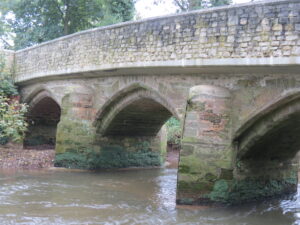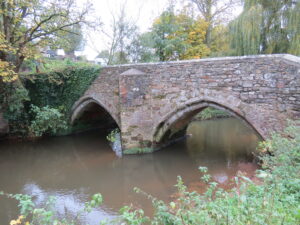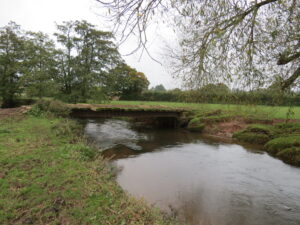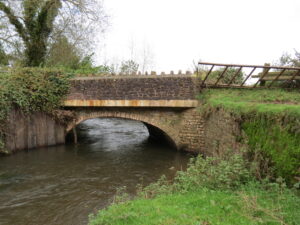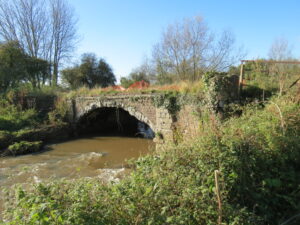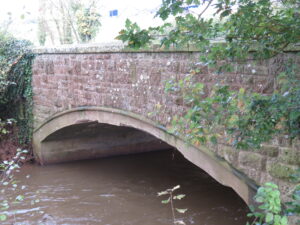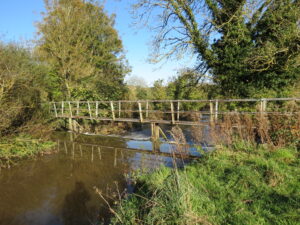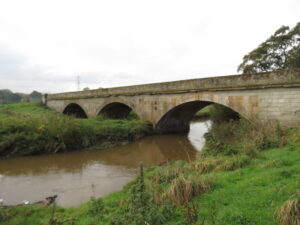| Road bridge built of local stone random rubble, ashlar dressings, red brick parapet, glazed blue tile coping. 20th century modifications, RSJ inserted and parapet rebuilt. Three arch span, 4-centred arches chamfered in 2 orders, cutwaters to central span, abutments probably rebuilt, road carried on RSJs, brick parapet with shallow brick piers, north west corner of parapet rebuilt late C20.1
When Jervoise visited the site in the 1930’s he noted ” The illustration shows how severely the beauty of the bridge has sufferred from this treatment”. He also suggests that this is the bridge referred to at the Quarterly Sessions of 1617 when it was stated that “Heale Bridge”, in the parish of Bradford, in the Hundred of Taunton, is now of late fallen greatly of decay.”
On complaint by several persons living in and about Bradford that the moneys collected for the repair of Tone and Heele Bridges are in private hands and have not been used as directed by the Court, and on an allegation by Mr. Richard Jeane and Mr. William, in whose hands it was conceived the moneys were, that the moneys are still in the hands of several constables ; the Court orders all such constables to pay the sums remaining in their hands, at or before next Sessions,to the said William Jeane and John Brewford of Bradford, and desires the nearest justice to bind over to the next General Sessions any who refuse or neglect to do so.2
Mr. William Jeanes and James Bruford, who were at last Bridgwater Sessions ordered to collect certain moneys for the repair of Tone and Hele Bridges, having refused to do so ; the Court desires John Turbervile, James Prowse and Edward Clarke, Esquires, justices, to take their account, and if they have not obeyed the said order, to bind them over to the next General Sessions.3Order to Mr. William Searle and John Brewford to collect from the constables of various hundreds the arrears still due from them for the repair of Tone and Hele Bridges, and to dispose thereof in accordance with former orders. If the former constables have not collected the said sums, the present constables are to collect them and pay them to Searle and Brewford. The justices are to help Searle and Brewford to see this order performed.4
Order to the constables of the hundreds of Bathe Forum, Brent with the liberty of Wrington, Froome, Glaston Twelve Hides, Horethorne, Huntspill and Puritan, Hartcliffe and Bedminster, Kilmersdon, Norton Ferris, Pitney, Stone and Catsaish, Somerton, Winterstoke, Whitstone and Wells Forum to collect forthwith the arrears of their proportions of the 222L. which was to be raised for the repair of the Tone and Heale Bridges in accordance with previous orders made at Ivelchester Sessions last, and to pay the same to Mr. William Searle and Mr. Jasper Woodhouse of the parish of Bradford, who are appointed to receive the same ; and appointment of John Brewford and Charles Grave of Bradford as surveyors of the said work. The justices are to bind over any persons, whether constables, surveyors or others, who refuse obedience to this order.5Whereas Heale bridge in the parish of Bradford in the hundred of Taunton and Taunton Deane is now of late fallen greatly in decay, and for that it is [not]* certainly known by whom the said bridge should be repaired, it doth fall more and more in decay, and the said parish is amerced for not repairing the same: Referred to John Symes, James Clercke, .and Robert Cuffe, esquires, to order and appoint by whom the said bridge shall be repaired.6
Whereas there was a reference heretofore unto certain Justices by whom the bridge called Heale bridge should be maintained : It is now ordered that there shall be no process made forth touching the same for that it cannot be amended till the spring of the year7
All amerciaments concerning Heale bridge [in Bradford Parish] shall be stayed according to former orders therein made ;and it is referred to John Symes, Thomas Brereton and James Clarke, esquires, or any two of them, to examine and see if the said bridge be amended according to the former orders, and to examine likewise if there hath been any issues levied for the said bridge, and to do therein as law requireth8
On a petition showing that where there hath been a county collection for the repairing of Heale bridge, some of the money has not yet been paid in, whereby the work is not finished, but likely to fall into decay again : Referred to John Symes, John Collis, Thomas Brereton, Robert Cuffe and Edward Lancaster, esquires, or any four of them, to examine what money is not collected, or collected and not paid in ; and also to call George Dynham, who was appointed overseer of the said work, to an account of what money he hath received and how he hath disbursed and employed the same, and farther to do therein as they shall think fit.9
Mr. Cuffe and Mr. Lancaster have certified that the Hundreds underwritten are behind in their payment of the county rate for the repair of Heale bridge ; and it is ordered that the Constables of the said Hundreds shall forthwith levy the rate required.10
In 1617 the Bradford parishioners pleaded at the Quarter Sessions that they should be freed from paying the enormous costs of repairing Hele Bridge on the grounds that it lay “in the uttermost boundes of our parishe and none of us have occasion to travell to the markett that way”. The Justices of the Peace for Somerset subsequently enrolled it as a County Bridge. It was badly damaged when Taunton was besieged in 1645 during the Civil War; several years later the Justices were still trying to raise funds to repair this and many other war-damaged bridges. Early in the 20th century the bridge was widened on both sides by the addition of steel beams
supporting concrete extensions with brick parapet walls; these were replaced by reinforced concrete and masonry in 2002. (11) |

